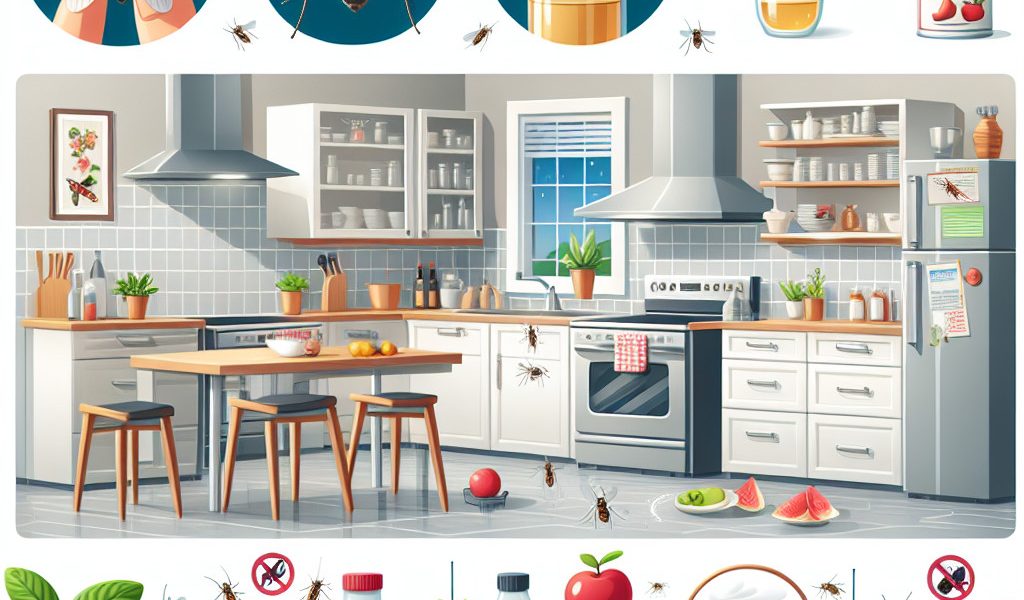Winning the War on Kitchen Midges: Natural Remedies and Prevention Tactics
Introduction
Midges are small flying insects that can invade our kitchens, especially in summer. They are attracted to sweet foods, overripe fruits or the presence of stagnant water. Although they are not dangerous for our health, their presence can be unpleasant and harm the hygiene of our culinary space. In this article, we offer you preventive solutions and natural repellents to get rid of midges in the kitchen.
Understanding the origin of midges
To better combat these unwanted little creatures, it is important to understand why they appear in your kitchen. The main causes of midge invasion are:
- The presence of sweet or fermented foods (overripe fruit, spilled juice)
- Stagnant water (sink not emptied properly, plants overwatered)
- Garbage not sealed tightly
- Lack of ventilation and regular maintenance of the kitchen
Maintain a clean and dry kitchen to prevent the appearance of midges
To prevent the invasion of these pests, here are some tips for maintaining a clean and dry kitchen:
- Store sugary foods in airtight containers or in the refrigerator
- Quickly dispose of overripe or rotten fruit
- Clean the sink regularly and be careful not to leave any stagnant water
- Empty the trash regularly and make sure it is tightly closed
- Ventilate your kitchen daily by opening the windows for a few minutes, especially after cooking.
- Completely clean your kitchen at least once a week (floor, worktop, cupboards, etc.)
To help you with this task, do not hesitate to call on cleaning professionals like Wecasa. They will be able to provide you with their expertise to keep your kitchen spotless and gnat-free.
Natural midge repellents
There are several natural solutions to keep these small unwanted insects away:
- Lavender essential oil: Dilute a few drops of lavender essential oil in a spray bottle filled with water. Then spray this mixture on the surfaces where the midges are found (work surface, window sills).
Note: Be careful not to spray this mixture on surfaces in direct contact with food.
- White vinegar: Mix white vinegar and water in a spray bottle (1 part vinegar to 2 parts water). Then spray this solution on the areas where the midges are found. Vinegar also has the advantage of disinfecting and degreasing surfaces.
Note: Remember to rinse the surface after use to avoid the lingering smell of vinegar.
- Repellent plants: Some plants have gnat repellent properties, such as lemongrass, basil or mint. Place these plants near windows or doors to keep these pests away.
Homemade or store-bought gnat traps
If, despite all these precautions, you still notice the presence of midges in your kitchen, here are some effective traps:
- Vinegar trap: Pour apple cider vinegar into a small container and add a drop of dishwashing liquid. Cover the container with plastic wrap and poke a few small holes in it. Gnats will be attracted to the smell of vinegar and become trapped in the liquid.
- Beer trap: Fill a glass halfway up with beer and add a drop of dishwashing liquid. The smell of beer will attract gnats which will then drown in the liquid.
- Store-bought traps: There are also midge traps sold in stores, such as sticky strips or insecticide spirals. These products can be effective, but make sure they are suitable for use in the kitchen and safe for your health.
Conclusion
Maintaining a clean and dry kitchen is essential to preventing the appearance of midges. By adopting a few simple actions and using natural repellents, you can keep these pests away from your culinary space. If necessary, don’t hesitate to call on cleaning professionals like Wecasa to keep your kitchen spotless and gnat-free.
